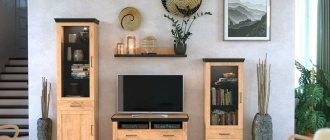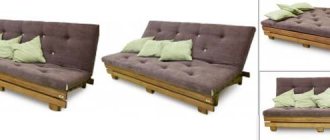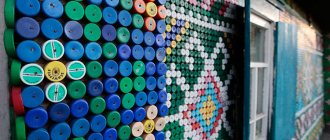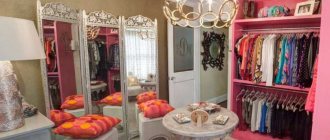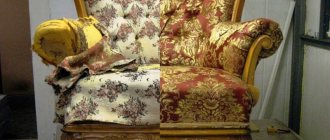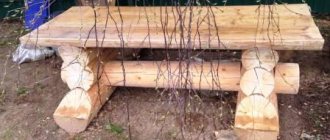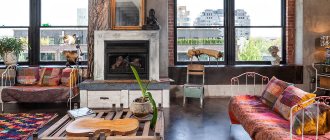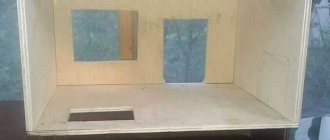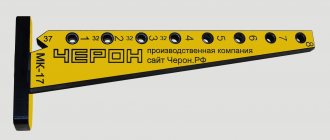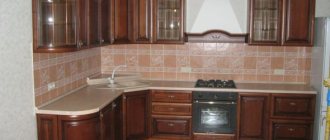Furniture made from environmentally friendly materials will never lose its popularity, however, in search of new forms and design solutions, interior design specialists are increasingly turning to plywood rather than natural wood. This material is ideal, as it allows you to produce not only durable and environmentally friendly furniture, but also experiment with shapes and product lines - plywood is easy to cut.
Despite the apparent simplicity of appearance, this material creates a special atmosphere in modern minimalist interiors. Making furniture from plywood is a fascinating process that even a beginner can handle. Today’s article is about the properties of materials and the features of working with them.
Making furniture from plywood
How to choose plywood for making furniture yourself
For self-production of furniture and other interior elements, plywood is most often used.
This material has gained such popularity due to its functionality. Plywood does not require complex processing and is lightweight, combined with strength and flexibility. In addition, the cost of laminated wood panels is significantly lower than that of natural wood. However, the plywood available on the market varies greatly. To get truly high-quality, reliable and beautiful furniture, you need to use the appropriate material. In addition, different types of plywood are suitable for different purposes. For example, if you are planning to make garden furniture, you will need waterproof FSF. Conventional furniture for home use is best made from 15mm thick birch plywood boards. For various types of interior structures - for example, podiums - more solid slabs will be required.
Features of plywood
Plywood consists of several (from 3 to 23) layers of wood veneer, glued together in a perpendicular direction. This solution allows plywood sheets to maintain flexibility with high strength.
To produce plywood, you need not only special knowledge and skills, but also high-tech equipment. To obtain high-quality material, the raw materials are first subjected to hydrothermal treatment, peeled from bark, divided into thin sheets and thoroughly dried. After this, the sheets are glued into one panel. Only a company with extensive experience and the necessary technical equipment can carry out all stages of production correctly and ultimately obtain a truly high-quality product.
What is plywood
Plywood is rectangular sheets consisting of 3 or more layers of wood fiber raw materials. It has the following characteristics:
- Humidity: 5 to 10%.
- Bending strength: not less than 55 MPa.
- Shearing strength: 1.5 MPa.
- Density: 665 kg/m3.
- Elastic modulus: 1400 N/mm2.
Plywood boards consist of the following parts:
- Bark: The outer layer of material. It is completely removed during processing.
- Growth zone: green fibers containing a large amount of moisture.
- Sapwood: wood with growth rings. In the central part of this layer is the core.
The plywood manufacturing process consists of the following stages:
- Receiving veneer. To do this, you need to soak the logs in hot water. This will reduce the hardness of the wood. The logs are cut into several short round pieces. Veneer is produced using circular peeling. During this procedure, the logs are placed on a woodworking machine. They rotate around a longitudinal axis. During this process, thin layers of wood are removed from the logs. When they are added, veneer is obtained.
- Elimination of defects. It is necessary to cut out rotten wood from the resulting veneer and remove knots. You need to put patches in their place.
- Gluing. Treated veneer sheets must be glued together. The first layers are laid in the transverse direction, the rest - at an angle of 90. Gluing is carried out using a press and heat treatment of the raw materials.
- Trimming. Glued veneer sheets are cut on woodworking machines, which makes it possible to align the ends of the plywood boards.
After the production processes are completed, the plywood boards are marked. The following information is indicated on the label:
- name of lumber;
- wood type;
- brand and type of wood;
- emission class;
- surface grinding features;
- veneer format;
- manufacturing standard.
The marking of laminated plywood may also indicate the brand of film.
Types of plywood
To understand how to choose plywood that is optimally suited to solve your problems, you need to understand what characterizes this material.
Plywood can be classified according to the type of wood used to produce it:
- Deciduous. As a rule, the starting material for it is birch. Sometimes - poplar, alder, maple, aspen. High density gives birch plywood special strength. It has a pleasant light shade and smooth texture. This has ensured her great popularity in the production of furniture and interior decoration.
- Coniferous. Pine, larch, and cedar are used as raw materials. Due to its saturation with resins, plywood made from coniferous wood has good moisture resistance. This makes it possible to produce furniture from it for rooms with high levels of humidity.
- Combined. The inner layers of such plywood are made of coniferous wood, and the outside is covered with hardwood veneer. Thus, combined plywood combines both strength and moisture resistance. It has found wide application in a variety of areas - construction, repair, furniture production.
Plywood can also be divided into 5 grades according to the quality of the outer veneer:
- Elite (E/A). It is almost impossible to buy plywood of this grade for making furniture yourself, because... its entire volume is purchased by manufacturing enterprises. Elite plywood is almost free of knots, cracks, glue residues and other defects.
- First (I/B).
- Second (II/BB). The first and second grades of plywood are distinguished by a minimal number of flaws, which makes them the optimal solution for home furniture making.
- Third (III/CP).
- Fourth (IV/C). The third and fourth grades can be used to implement interior ideas that require a finishing coating - for example, podiums. Plywood is also divided depending on the degree of processing:
- Unsanded (NS).
- Polished on one side (Ш1).
- Polished on both sides (Ш2).
Sanded plywood has found wider application in furniture production. Unsanded material will have to be processed using sandpaper.
There are also many varieties of plywood depending on the water resistance of the adhesive impregnation. Materials such as FBA can be used to make home furniture. This brand is glued with natural glue, which allows it to be considered the most environmentally friendly type of plywood. However, it belongs to non-moisture resistant varieties. There is also a super-strong brand of non-moisture resistant plywood - BV. It is impregnated with bakelite varnish. Brands FB, FBS and BS are also characterized by strength due to impregnation, however, alcohol-soluble varnish was used in their production, due to which they are resistant to moisture.
To make home furniture from plywood with your own hands, you can use the FK brand. It is not suitable for outdoor furniture, as it has average water resistance. If you want to make garden furniture, you can choose the FSF grade. But it is not suitable for a home environment. Moisture resistance is accompanied by a high content of chemicals, which is unacceptable for use inside buildings.
A universal option that is suitable for both indoors and outdoors is laminated plywood. This material is not afraid of mechanical loads, the effects of aggressive external factors, and does not require finishing.
Plywood is perfect for making furniture yourself. It combines cost-effectiveness with reliability, flexibility and ease of processing. The main thing is to choose the material in accordance with the tasks for which it is intended.
The All-fanera company sells plywood of various brands and grades at affordable prices. If you wish, you can arrange delivery with us throughout Moscow and beyond.
Step-by-step instructions for making simple furniture items from plywood
It is recommended to start making plywood furniture with the simplest designs, gradually acquiring and improving the skill of working with this material.
Rocking chair
Making your own rocking chair will be an excellent option to try your hand at carpentry. And you shouldn’t be afraid that the furniture will have some flaws - imperfections can be hidden with the help of painting or decorative textiles.
Table 3. Making a rocking chair
| Illustration | Description |
| Plywood | To make such a chair you will need plywood sheets with a thickness of 15, 10 and 4 mm. |
| Stage 2: making a sketch. | First you need to make patterns for cutting out parts. The pattern drawing is made on thick paper or cardboard on a scale of 1:1. |
| Stage 3: cutting out parts | The patterns are cut out and with their help the contours of the part are transferred to plywood sheets, trying to fit them as economically as possible. |
| Stage 4: preparation for assembly | The parts are cut out using a jigsaw. Holes for fastening are immediately made in the required places. Before you begin assembling the product, all parts must be thoroughly sanded. You will immediately need to prime and paint the parts. |
| Stage 5: making the seat and backrest | To make the back and seat, plywood strips are used, which are fixed with glue on thin sheets of plywood 4 mm thick. |
| Stage 6: frame assembly | First, the frame of the product is assembled. |
| Stage 7: Assembling the seat and backrest | After this, the back and seats are fixed. The attachment points are masked with strips. |
Finished rocking chair
Plywood stool
A stool is an easy-to-make and versatile piece of furniture. To make it from plywood you will need the following.
Table 4. Making a stool
| Illustration | Description |
Step 1: marking | On plywood 20 mm thick, 200 mm wide and 430 mm long, mark the leg of the stool. It is recommended to think through the shape of the legs in advance by completing a sketch drawing. The part is cut out using a jigsaw. It is used as a template for making three more of the same parts. |
Step 2: Cutting | The part is cut out using a jigsaw. It is used as a template for making three more of the same parts. |
Step 3: Sanding | The cut parts are polished. |
Step 4: making the seat | The seat measures 320 x 320 mm. Having cut out a square, use a jigsaw to make the corners rounded. |
Step 5: Sanding the Seat | The seat is sanded on top and at the ends. |
Step 6: Milling the Seat | All parts are processed with a semicircular cutter, which can be replaced with sandpaper. |
Step 7: Milling the Legs | The cutter is also used to process the legs of the future stool. |
Step 8: Preparing for Assembly | Make holes for self-tapping screws. |
Step 9: preparing holes for screws | Then, using a drill of a larger diameter, the holes are countersunk so that the fastener heads are recessed when screwed in. |
Step 10: Assembling the Product | Start assembling the product. To prevent delamination of the plywood, the parts are drilled with a No. 3 drill and the screws are tightened. |
Step 11: Fixing the Legs | Fastening the legs crosswise is very strong due to the fact that each leg will be held on by 4 screws. |
Step 12: Marking | The legs are installed on the lid and markings are applied so that a hole for a self-tapping screw is located in the center of each leg. |
Step 13: Preparing the Holes | Holes are drilled in the lid according to the markings. The holes are countersunk. |
Step 14: Assembling the Product | The product is assembled using self-tapping screws. |
Step 15: Finishing | After the product is assembled, the holes are puttied and varnished. |
Nightstand
A bedside table is considered easy to make. You can do it yourself as follows.
Table 5. Making a bedside table
| Illustration | Description |
Step 1 | The cutting of the material is carried out according to the drawing and the selected dimensions of the parts. To prevent the plywood from cracking when cutting, you can place a couple of sheets of polystyrene foam underneath it. |
Step 2 | For edging the parts, strips cut from 4 mm plywood are used. The protruding excess is removed with a milling cutter. |
Step 3 | Then the edges are sanded. |
Step 4 | To assemble the bedside table, birch furniture dowels 8 x 40 are used. Holes are drilled for them. |
Step 5 | Dowels are driven into the holes. |
Step 6 | Assemble the frame of the cabinet by inserting dowels into the holes, pre-lubricating them with glue. |
Step 7 | When assembling boxes, a tenon joint is used. |
Step 8 | To do this, the workpiece is marked for a tenon joint. |
Step 9 | The holes are cut according to the markings using a jigsaw. |
Step 10 | And then gouge it out using a chisel. To avoid the formation of chips, the inner side is lightly pounded, and the front side is completely knocked out. |
Step 11 | In the place where the bottom is attached from six-millimeter plywood, the part is milled. |
Step 12 | When assembling the box, the grooves are lubricated with glue. |
Step 13 | The façade is secured with self-tapping screws. |
Step 14 | Guides are fixed inside the cabinet and on the sides of the drawer. |
Table 6. Making the base of the cabinet
| Illustration | Description |
Step 1 | To make the base, use 4 parts with edges beveled at 45 degrees. |
Step 2 | The frame parts are fixed with dowels and glued together. |
Step 3 | The end of the part and the dowel inserted into the previously prepared hole are lubricated with glue. |
Step 4 | The structure is pulled together and left to dry. |
Step 5 | The legs are glued and fixed to the base. |
Step 6 | Edges are glued to the ends of the base. |
Step 7 | The edge is smoothed with a router. |
Step 8 | A chamfer is removed along the perimeter of the base. |
Step 9 | The base is sanded. |
Table 7. Product assembly and painting
| Illustration | Description |
Step 1 | The boxes are coated with colorless parquet varnish. |
Step 2 | The frame is assembled using dowels and PVA glue. |
Step 3 | Painting is carried out in two times - the first layer is applied with a brush, the second with a spray. |
Step 4 | At the final stage, the product is coated with oil and hard wax. |
Video - DIY plywood bedside table
Features of furniture plywood
Advice! For the production of kitchen furniture, only plywood with a high level of moisture resistance should be used. The best option is FSF sheets. Otherwise, such pieces of furniture will quickly lose their attractive appearance under the influence of moisture and frequent temperature changes.
Advantages and disadvantages of plywood sheets compared to wood
Materials such as furniture board or plywood are successfully used in furniture production, and today, much more often than natural wood. As mentioned above, the main reason for this is the low price of plywood sheets.
However, in practice this material has a significant number of advantages.
Let's look at some of them:
- It consists of wood, only from thin layers (about 1 mm), and its price is an order of magnitude cheaper.
- Even large plywood sheets are shaped stable. This is achieved due to a special production technology - crossing veneer fibers.
- True freedom of choice regarding sizes.
- High lateral strength when compared with a wooden panel of the same thickness.
Unfortunately, this material has in addition to its advantages.
It also has some disadvantages:
- The mass of a plywood sheet will be greater than that of a wooden sheet of similar thickness.
- The ends have stripes, which affects the aesthetic perception of the product, since many have a negative attitude towards plywood as a material.
Lining the ends of plywood.
Advice! If you don't want the veneer layers to be visible on the ends, they can be sealed or coated with several layers of dark varnish.
- This material gives you less freedom in surface treatment, since the front layers are about 1 mm thick, so they can be “removed” with a tool if you are careless.
- Some manufacturers save on adhesives by using adhesives that are harmful to human health. Thus, purchasing plywood from an irresponsible manufacturer can have unpleasant consequences, which cannot be the case with the purchase of natural wood, even of the lowest quality.
Other selection factors
The choice of plywood sheets for furniture manufacturing is influenced by the following factors:
- Variety Elite is the best choice. But it cannot be found on the open market, since it is sent in bulk to furniture factories on special orders. But grades 1 and 2 are also good options. To save money, you can choose 1/2 or 1/3 grades. The front side will be the one whose outer layer of veneer is grade 1. The reverse side will be wrong side.
- Thickness. For cabinet furniture, the optimal thickness is 15-18 mm. For podiums – at least 20 mm. For non-load-bearing partitions, thinner sheets can be used - about 8-10 mm. For sealing the back wall of furniture and constructing the bottom of drawers, plywood 3 mm thick is suitable. For this purpose, you can also purchase cheaper fiberboard material.
- Surface treatment method. Plywood must be sanded on both sides. To save money, you can buy unsanded sheets, but in this case you will have to sand them yourself.
When choosing plywood for furniture, also pay attention to its format. It should be enough to cut workpieces of specified sizes. Please note that the standard size of FC sheets is 1525x1525 mm. To prevent the formation of seams in unnecessary places when making large-sized furniture, it is better to purchase laminated plywood, which is produced in the 2500x1250 mm format .
Source: green-ply.ru
Features of making furniture from plywood
Knowing about the flexibility of plywood in work, many home craftsmen have probably thought about making their own furniture. And in reality there is nothing particularly complicated here - you just need to follow simple recommendations in your work.
The instructions for working with plywood provide several tips:
- This rule applies to working with sheets of different thicknesses:
- The thickness of which is no more than 1.5 mm. In this case, the material should be cut exclusively with a knife.
Cutting a sheet using a stationery knife.
- If the thickness is more than one and a half millimeters, but less than six, then you should use a jigsaw.
- If the sheet is more than 6 mm thick, it will have to be cut with a circular saw.
- Never cut plywood boards across the grain, as this will cause the material to crack. To prevent this, loosening cuts should be made. They are made using a knife, applied parallel to the sawing line.
- Before joining sheets with screws or nails, it is necessary to pre-drill holes, otherwise cracks will form in the material.
Advice! If you are connecting building materials made of soft wood with screws, then you should place small washers under their heads.
- To bend the panel, you must first moisten it with water and then fix it. The sheet should be kept in this position for about 12 hours.
Bend the panel using the tire to give it shape.
- There are simple instructions for gluing plywood:
- It is necessary to start by sanding the area of gluing with sandpaper.
- Apply the adhesive composition in an even thin layer.
- We compress the material until it dries completely.
Advice! If the glued sheets will be used in conditions of high humidity, then waterproof glue should be used. When gluing, it is necessary to maintain strict parallelism of the fibers.
- In case of peeling of plywood, it is necessary to use paper pads to glue its layers.
Methods for decorating a plywood surface
Once the product is assembled, you can begin decorating it. In some cases, it is enough to coat the plywood with a protective matte transparent varnish - this will preserve its shade and pattern. In other cases, surface finishing methods are used that change the original shade of the product - oil treatment, painting.
Bright colors highlight the original shape of children's furniture
Bright, rich shades are used when dyeing when the shape and color of the product dominate.
A birdhouse made of plywood is an excellent opportunity to simultaneously take care of birds and practice carpentry. A homemade bird house can decorate the balcony of a multi-storey building or a garden plot. The work process is simple, you just need to follow the rules and recommendations. We will talk about them in a special article.
Set of children's furniture made of plywood
One of the original ways to decorate plywood furniture is the decoupage technique. This method of decoration is relevant for furniture in the style of vintage, Provence, and shabby chic. Using this technology, you can diversify the appearance of furniture with a simple shape.
It is worth noting that the “decoupage” technique is simple to perform and does not require special skills: the base is primed, a pattern is glued on top and varnished.
Decor made using the decoupage technique
Table 8. Decorating a plywood tabletop
| Illustration | Description |
Step 1 | The surface of the table top is sanded using sandpaper. |
Step 2 | Prime the surface using white acrylic paint. The primer must be applied with a brush in two layers. |
Step 3 | When the soil dries, its top layer is leveled by grinding. |
Step 4 | The prepared surface is covered with paint of the selected shade. |
Step 5 | Painting tape is applied around the perimeter of the tabletop to mark borders. |
Step 6 | The borders are painted in the required color and after the paint has dried, the tape is carefully removed. |
Step 7 | The tabletop is covered with lace fabric, which is fixed with clothespins. |
Step 8 | The tabletop is painted with contrasting spray paint through the lace, which is left on the surface of the tabletop until the paint has completely dried. |
Step 9 | After removing the lace, the tabletop is coated with several layers of transparent varnish. |
What is plywood and why is it so valued?
Plywood is a sheet material that has a layered glued structure of three or more sheets of wood. Each layer of veneer is applied so that its fibers are perpendicular to the previous sheet. Thanks to this, plywood has high strength, rigidity and dimensional stability, which distinguishes it from ordinary wood.
For the outer layers of plywood, veneer of deciduous trees (birch, alder, maple, beech, linden, etc.), less often of coniferous trees, is used. Its thickness does not exceed 3.5 mm. For the inner layers, it is allowed to use veneer of both hardwood and softwood, in the latter case we are talking about the so-called. combined plywood.
Classification by purpose
There are the following types of plywood according to their intended purpose:
- Ship's. Used in the repair of sea vessels for cargo and passenger transportation. They do not lose their strength when in contact with seawater and can work in various environments.
- Furniture. Used in the manufacture of furniture and accessories. This type is environmentally friendly and has a long service life.
- Aviation. Used in aircraft manufacturing. It is resistant to aggressive environments and has high strength.
- Formwork. Designed for formwork. This type includes laminated plywood.
- Automotive. Used in the automotive industry. It has a mesh-ribbed surface.
Construction plywood is the most popular. It is used for interior and exterior decoration of premises. 80% of construction plywood sheets are made from birch.
How thick is plywood?
According to GOST 3916.1-96 , plywood sheets with thicknesses of 3 mm, 4 mm, 6.5 mm, 9 mm, 12 mm, 15 mm, 18 , 21 mm, 24 mm , 27 mm and 30 mm are available on the market. But if necessary, manufacturers can create material of any thickness agreed with the customer. The material can contain from 3 to 21 layers of veneer. The thickness of the sheet determines which saw to cut the plywood with. Typically a circular saw is used for these purposes.
What types of plywood are there?
Plywood is classified according to many parameters:
- operational purpose (construction, general use, furniture, decorative, etc.);
- degree of water resistance of the adhesive joint;
- type of surface treatment (polished/unpolished);
- thickness and number of layers;
- sheet dimensions;
- emission class, etc.
However, the main criterion that determines the characteristics of a plywood sheet is its grade indicator.
Intelligible information about plywood varieties
There are five grades of plywood. The belonging of a material to one or another grade is determined by its visual and aesthetic characteristics, i.e. quality of external veneer and the number of permissible defects.
According to GOST 3916.1-96, plywood grades are designated “ E ”, “ I ”, “ II ”, “ III ”, “ IV ”.
Along with this marking, the old classification system established by GOST 3916.1-89 . In accordance with it, plywood is also divided into five grades, but they are designated differently: “ A ”, “ AB ”, “ B ”, “ BB ”, “ C ”. Since both indexings are still used, for convenience we will give the old markings in parentheses.
Grade E (A). Elite class plywood that has no visible flaws or processing defects on its surface. According to established standards, only minor defects in the form of an uneven textured pattern are allowed in such material. The presence of knots, holes, cracks and wormholes, shoots and other wood defects is not allowed.
Grade I (AB). This type of plywood may have defects in the outer veneer layers, but within strictly established limits. The length of warping and cracks should not exceed 20 cm, and the number of such defects cannot be more than 2 pieces. per 1 m of sheet width. In first grade plywood, such defects as lack of veneer, healthy intergrown light and dark knots with a diameter of no more than 15 mm in an amount of no more than 5 pieces are allowed. per 1 m 2. Open cracks, dark growth, unhealthy discoloration, dents and other defects are excluded.
Grade II (B). The plywood sheet may contain cracks up to 20 cm long, patch inserts, and mechanical defects such as scratches or dents. There may be slight leakage of glue and overlap of the top layer veneer. One sheet of second grade plywood is allowed to have up to 6 of the following defects: dark and light knots, holes, wormholes with a diameter of no more than 6 mm.
Grade III (BB). A plywood sheet of the third grade may contain both healthy and partially fused or fallen knots, wormholes with a diameter of up to 6 mm (up to 10 per 1 m2). GOST allows for patch inserts, gaps in veneer joints, moderate glue seepage, edge defects, overlaps and veneer shortages.
Grade IV (C). The lowest quality type of material. In the fourth grade, all plywood defects are allowed in unlimited quantities.
In the marking, the grade of plywood sheet is indicated through a fraction, for example, I/II. This means that veneer of the first grade was used for the front side, and second grade for the back.
Plywood on the Russian market
According to their operational purpose, plywood is divided into the following types:
- construction plywood;
- general purpose plywood;
- Bakelized plywood;
- laminated plywood;
- furniture plywood;
- decorative plywood;
- aviation plywood, etc.
There is also a division of plywood by grade, grade, thickness, emission class, design and sheet format, as well as by type of surface treatment and wood species from which it is made. There are five grades of plywood, which are designated differently in accordance with different GOSTs.
| Plywood grade | |
| GOST 3916.1-96 | GOST 3916.1-89 |
| E | A |
| I | AB |
| II | B |
| III | BB |
| IV | C |
All this presupposes the presence of a huge assortment of finished products produced by industry, and sellers are not always able to competently answer customers’ questions about the specifics of the use and further behavior of a particular type/grade of plywood in certain conditions. However, if you are choosing plywood for any important project, you should first find out whether any particular type/grade is suitable for your purposes and conditions.
On the Russian market, plywood is divided into grades depending on the appearance of the surface, into grades according to the degree of water resistance of the adhesive joint, and into sanded and unsanded according to the degree of surface treatment.
The different grades differ mainly in the quality of the veneer and the number of permissible defects.
Plywood grade E (A). This is an elite plywood that does not have visible defects or defects on the surface of the sheets. Occasional defects in the form of violations of the texture pattern are allowed, but the presence of dark eyes on the surface of plywood E is unacceptable. There should also be no knots or holes from them, minor brown veins, wormholes or other defects. Grade E plywood is practically never found in retail trade, as it is usually used to make laminated plywood.
Plywood grade I (AB). The standard allows a maximum length of warped or cracked veneer of no more than 20 cm, as well as no more than three defects such as veneer shortages, healthy or fused knots, holes from fallen knots, sheet edge defects of no more than 2 mm, as well as wormholes with a diameter of no more than 6 mm (up to three per 1 m²).
Plywood grade II (B). A plywood sheet may contain cracks up to 20 cm, wood patches, scratches and dents, the area of which should not exceed 5% of the total area of the plywood sheet. Adhesive seepage in an area of up to 2% of the area of the plywood sheet and veneer overlap in the outer layers of the plywood sheet with a width of no more than 10 cm are allowed. In accordance with the standard, no more than six of the following defects are possible on one plywood sheet: knots (light, dark, healthy and fused) , holes from fallen knots, wormholes (no more than six per 1 m² with a diameter of each of them no more than 6 mm).
Plywood grade III (BB). The following are allowed in a plywood sheet: pin, healthy, partially fused and fallen knots; up to ten wormholes per 1 m² (with a diameter of each no more than 6 mm). The total number of such defects should be no more than nine. Also allowed are patch inserts, gaps in veneer joints (no more than 2 mm wide), glue leakage with a total area of no more than 5% of the area of the plywood sheet, veneer shortages, various edge defects (no more than 20 cm wide), as well as veneer overlap ( width no more than 20 cm).
Plywood grade IV (C). Plywood sheet is the lowest quality of all. In such a sheet, partially fused and fallen knots, wormholes with a diameter of up to 40 mm, as well as veneer shortages and defects in sheet edges up to 5 mm in depth are allowed without restrictions. When designating the grade of plywood sheets, the grades of veneer on the front and back sides are taken into account. In Russia, different manufacturers designate plywood grades either by letters or Roman numerals, for example: AB/V (I/II), V/V (P/11), V/VV (P/Sh), VV/VV (III/III ), S/S (IV/IV).
Depending on the degree of water resistance of the adhesive joint, the following grades of plywood are distinguished.
FSF is plywood with increased water resistance for indoor and outdoor use. It is made from birch, beech or pine veneer using phenol-formaldehyde resins, which provide such material qualities as water resistance, mechanical strength and wear resistance. But FSF also has disadvantages. The resins used for gluing veneer contain a fairly high concentration of toxic phenolic compounds. Another significant drawback is flammability, and the combustion products of resins are also quite dangerous to health.
Degree of water resistance of the adhesive joint
In addition to the type of veneer, plywood differs from each other in the characteristics of the adhesive connection. Based on this indicator, the following grades of material are distinguished.
FSF is a material of increased water resistance for external and internal use. The adhesive joint of plywood is created using phenol-formaldehyde resins. Thanks to them, the material is characterized by increased water resistance, mechanical strength, dimensional stability, and wear resistance. The flip side of the advantages of FSF brand plywood is the high percentage of toxic phenolic compounds. In addition, the resin used for gluing veneer is flammable, and the combustion products of the resins themselves pose a real threat to human health.
FC – waterproof plywood for internal use based on urea glue. This type of material differs from the FSF brand in lower water resistance, but at the same time it is completely environmentally friendly and odorless. FK brand material is chosen for interior decoration of residential and technical premises, creating furniture, etc. The environmental safety of plywood and low flammability make it optimal for burning.
FB is a highly water-resistant plywood that uses bakelite varnish. In addition to resistance to critical humidity levels, this material demonstrates unsurpassed mechanical strength, wear resistance and is adapted to large temperature changes. FB plywood retains all its operational advantages even with prolonged contact with water.
Plywood for environmental safety
Since the production of wood-based panels uses a substance such as formaldehyde, a generally accepted scale has been developed that determines the level of permissible formaldehyde emissions. Based on the level of emission of harmful substances, plywood can be classified as class E1 or class E2.
E1 grade plywood
Class E1 includes materials that emit no more than 10 mg of harmful substances per 100 g of dry wood. Such indicators are considered acceptable for the use of plywood in residential premises.
E2 grade plywood
E2 class boards are recommended for use only for outdoor use, as the emission level can reach 30 mg.
At the same time, some unscrupulous manufacturers often indicate in the annotations to their products a class that does not correspond to reality. Using such materials in certain conditions is quite risky, so it is advisable to give preference to trusted manufacturers.
What to look for when choosing plywood?
The brand, grade and thickness of plywood are the main criteria that are used when choosing a material.
Guests may differ, but it is better to always check the quality of the material yourself. To decide which plywood to choose, first inspect the edges of the material. In high-quality plywood, the inner layers of veneer should be straight, of the same thickness, without overlaps or gaps. The heterogeneity of the internal layers not only worsens the performance qualities of the material, but can also appear on the outside of the plywood sheet and create unnecessary problems when cutting it and at the finishing stage.
Before purchasing plywood, it would be a good idea to visually assess the straightness of the sheet. Even a small bend can turn into serious warping due to the release of internal stresses after the sheet is cut.
And, of course, when choosing a suitable sheet of plywood, always evaluate the number of external defects against the indicators of the material grade.
Plywood for furniture. Types and grades of plywood. Materials Science.
| [td] Wooden kitchen is a very vague concept. The materials for it include both expensive solid wood glued together from natural wood beams and budget slabs pressed from sawdust and various binding resins (including formaldehyde). But if you’re going to make a kitchen with your own hands, you should choose the golden mean – plywood. It is quite affordable, easy to process and more environmentally friendly compared to the same chipboard What does a furniture maker need to know about plywood? Plywood is a kind of “pie” made from thin sections (from 0.1 to 1.18 mm) of solid wood - veneer. There is always an odd number of layers, and they are laid perpendicular to the direction of the wood fibers. The sections are joined using high-pressure adhesive, resulting in a durable, wear-resistant material. Composition - for the manufacture of plywood, veneer is used from coniferous (pine, spruce, fir, larch, cedar) or deciduous (most often birch, linden, oak) tree species. Based on the number of layers, it is divided into three-, five- and multi-layer. |
Types of plywood.
There are several main types of plywood, depending on the material used.
Apart from the finishing methods used to process finished material, it is the base from which this or that type of plywood is produced that determines its performance characteristics in the future. Each type of wood has its own individual characteristics and properties, which means that a product made from trees of a particular species will be endowed with such properties to a certain extent. Let's look at the characteristics of the main types of plywood:
Birch plywood . Birch plywood, due to the properties of the wood from which it is made, is distinguished by its highest strength. Of course, this is precisely the quality that determines to the highest degree the demand for this material. The most common type of birch plywood used for interior decoration and furniture making is FC plywood , which is also characterized by an average level of moisture resistance and environmental friendliness. Among other things, this plywood has a pleasant color scheme and pleasant texture, and is easy to process. birch plywood is best suited for outdoor work, since it is a more moisture-resistant material and is actively used in construction, formwork, mechanical engineering, etc.
Coniferous plywood . The main characteristic of plywood, which is made from pine wood, is high strength with relatively low weight, which makes it the best option for use in house construction. This plywood also looks great. Work such as creating bases for floors, cladding walls, erecting partitions, covering roofs - in low-rise housing construction is often carried out using coniferous plywood. In addition, coniferous plywood best meets the needs of the furniture industry, packaging manufacturers, interior designers, etc.
Combined plywood (birch/coniferous). Combined and birch plywood are similar in appearance, however, due to the fact that the birch and coniferous veneer in combined plywood are glued together in layers that alternate, the cost of this material is somewhat lower. If we talk about strength, then combined plywood is not as strong as birch plywood, however, it is stronger than coniferous. This set of characteristics has made this wood-based panel material in demand for performing the same work as birch plywood, and interior decoration is also one of the main areas for using combined plywood.
Unidirectional plywood . This type of plywood is fundamentally different from other varieties in that almost all veneer layers in it are directed in the same direction - which is why unidirectional plywood is a very elastic wood-based panel material. The specificity of such plywood has made it in demand in the manufacture of upholstered furniture, and, for example, hockey sticks are made exclusively from plywood of this type.
Laminated plywood . The lamination effect is achieved by covering the plywood with a special film (based on phenol-formaldehyde resins). This coating significantly increases the wear resistance and moisture resistance of ordinary plywood, having a key effect on density and strength. The layers of wood veneer in such plywood are also glued together with glue based on phenol-formaldehyde resins. Such plywood is used for purposes in which wear resistance plays a key role - formwork, floors, various types of cladding, up to the construction of bridges (large format plywood is used).
Bakelite plywood . This type of plywood has its own special characteristics - it is indispensable for use in aggressive environmental conditions - sea salt water or, for example, a hot tropical climate does not subject it to destruction. This plywood is made from birch veneer using bakelite varnish as an impregnation.
Class “E” plywood is considered the best - during its production the presence of knots, cracks, chips and wormholes is not allowed. It is used in finishing work and in the manufacture of furniture, since the smooth surface is ideal for any finishing treatment and looks beautiful when opened with varnish, paint, wax or oil impregnation. The remaining grades (from 1 to 4) allow an increasing number of defects, and if with grades 1 and 2 you can still try to save money, then with grades 3-4 I should experiment - the large amount of waste and low quality of products are not worth it.
Plywood by type of front surface
One of the parameters by which this material is classified is the technology used in production for processing the external surfaces of plywood. Based on this criterion, several types of plywood are distinguished.
1. Unsanded (NS) - the outer surface of the veneer is not subjected to additional processing, as a result of which it has a fairly rough structure. The risk of cracking increases. Mostly such materials are used for rough work, where the condition of the surface of the slabs is not of fundamental importance.
2. Ш1 – sanded plywood, processing of which is carried out on one side. Practically not prone to cracking.
3. Ш2 – material that is subjected to grinding on both sides. The ability to absorb moisture is minimized. As in the cases with Sh1 plywood, it can be used for finishing work, as well as in the manufacture of decorative products and individual structural elements of furniture.
4. Laminated plywood sheets , for the processing of which special resins are used that contain phenol and melamine. It is also relevant to apply PVC film to the surface of plywood. Thus, the moisture resistance of the material improves. Lamination allows you to extend the service life of wood boards. In addition, the external surface looks quite aesthetically pleasing. This type of plywood is often used in interior design.
Types of plywood.
Sorting - changing the grade depends on the defects of the wood, which has 28 points.
Marking - depending on the adhesive composition, plywood is distinguished:
- FC (urea glue),
- FKM (melamine resins),
- FBA (albumin casein glue),
- FSF (phenoformaldehyde),
- FB (bakelite varnish),
- BS (alcohol-soluble bakelite glue).
Of course, not a single composition reaches absolute environmental friendliness (after all, it is a product of the chemical industry), but FBA plywood, the glue for which is made on the basis of protein, is considered the safest for health.
Plywood based on formaldehyde glue has emission class indicators for harmful substances (like chipboard). For residential use, it is recommended to purchase materials marked E0 or E1.
Surface treatment - unsanded plywood is designated “NSh”, with one sanded side - “Sh1”, with both sides - “Sh2”.
Dimensions - standard plywood sheets can be either square or rectangular. The minimum length is about 1.5 m, the maximum is a little more than 3 m. And the thickness varies from 3 to 30 mm.
Tips for processing plywood
Giving the necessary shapes to plywood sheets
In order for your plywood furniture for the veranda, hall or kitchen to turn out beautiful and even, you must follow certain rules for processing the material. They are quite simple and do not require any special processing tools.
So one of the most important processing elements is the cutting process. Glued veneer is cut depending on its thickness up to 1.5 mm using a knife. If the thickness is up to 6 mm, cutting is performed using a jigsaw; for larger thicknesses, a circular saw is used. Carry out cutting as shown in the photo
The instructions advise cutting sheets of laminated veneer plywood only along the grain, otherwise the veneer may delaminate during the sawing process. If you need to make a cut across the grain, you must first make weakening cuts along the cut line. This can be done with a regular mechanic's knife. Laser cutting of plywood is also a worthy alternative to a knife.
The process of bending laminated veneer, although quite simple, will require a lot of time and perseverance. To do this, the sheets of building material should be wetted. It should be wetted sufficiently and after soaking the building material with water, begin bending. Having bent it to the required or intermediate parameters, it should be fixed and allowed to dry for at least 12 hours. And although the process is quite long, it is worth it, because kitchen or toy furniture made from bent plywood looks very original.
Fastening plywood sheets
Fastening plywood with nails or screws is possible only after pre-drilling them. The holes must match the size of the connecting element. If your building material is made of soft wood, then a soft gasket should be placed on the screws or nails. It will protect the plywood sheet from pressing and cracking. It is optimal to use this type of fastening no closer than 12–15 mm from the edge of the sheet.
Fastening is carried out only after preliminary drilling
The process of gluing plywood requires its pre-treatment. So you should sand the surface; for this it is better to use abrasive paper No. 80 - 100. Then sweep away the resulting dust and apply adhesive to both surfaces. We compress the surfaces to be glued and leave them under load until the glue dries completely.

